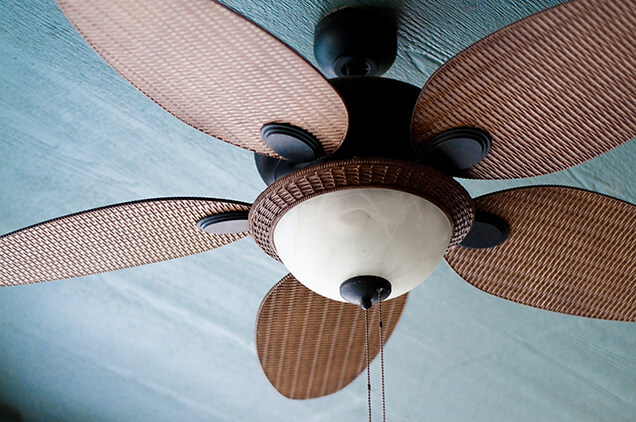Almost all homes have at least one ceiling fan installed, and chances are you use it through most of the summer and winter. However, most people don’t have a good handle on the whys and hows of using their ceiling fan. Consider the following common questions we field regarding residential ceiling fans.
1. Are All Ceiling Fans the Same?
The first difference you need to know about ceiling fans is that there are differences between indoor and outdoor-use fans. The ones used inside are typically dry-rated, which means the motor is not designed to deal with excessive moisture. If you’re looking for one to use on a patio, you’ll want one that’s rated for outdoor use. Next, consider how the fan runs, the motor it uses, and the amount of air it pushes. The motor the fan uses, along with the number of blades and their size, makes a tremendous difference in how it affects your space. These also make a difference in how much noise the fan makes and its efficiency. Generally, four-blade models are more efficient than equivalent 5-blade models because they are lighter.
2. Do Ceiling Fans Cool Your Space?
It’s common to use a ceiling fan while trying to cool a space. However, they don’t actually cool a space. Rather, what ceiling fans actually do is move air, which creates what’s known as the windchill effect. Just like what happens in the winter, the air simply moving across your skin makes you feel cooler. In fact, this phenomenon can make your room feel as much as 8 degrees cooler than it actually is.
Further, ceiling fans help with air circulation, so the cool air that your AC produces will distribute more evenly. This helps prevent hot or cool spots in your room, increasing your overall comfort.
3. Why Is My Fan Noisy?
Ceiling fans may make a variety of noises for a host of reasons. First, understand that this is one of the differences in fan quality and price. Higher-quality fans tend to make less noise. However, an older unit may also produce more noise due to loose and worn parts. Common issues that may cause excess noise include a worn motor, unbalanced blades, loose mounting hardware, improper installation, and dirty or worn bearings.
4. Should You Replace the Blades?

Depending on your fan model, you may be able to find replacement blades. The reason you may want to replace them is if they are significantly warped or damaged. Blades may already be slightly bent or warped because they are made from semi-flexible material. Take them all off the fan and stack them on top of each other. If a blade is warped more than 1/4 inch, then you should consider replacing it. If you’re using a generic replacement blade, make sure it fits with your mounting hardware and consider replacing all of them to avoid making the fan off-balance.
5. What Direction Should Your Ceiling Fan Rotate?
It’s important to make sure that your ceiling fan is spinning in the proper direction to get the most benefit from it. There’s a switch on the fan housing that toggles whether the motor spins clockwise or counterclockwise. Over the summer, the ideal setting is counter-clockwise. This pushes air down, creating the windchill effect mentioned earlier. Conversely, you want the fan to spin clockwise over the winter to push the warm air that rises to the ceiling back down where it’ll more effectively warm your living space.
6. How Fast Should Your Ceiling Fan Spin?
The speed you want your fan to spin also depends on the season. Over the winter, when it’s spinning clockwise, you want to run it on low. This creates the updraft without moving enough air to cause a cooling effect. Over the summer, the speed depends on what you find comfortable. The faster it spins, the more air it’ll move and the cooler it’ll make the space feel. However, keep in mind that the faster it spins the more energy it will consume, so balance its speed with the energy it consumes. Try running it on low or medium unless it’s extremely warm, then increase to running it on high.
7. Should You Clean Your Ceiling Fan?
As your ceiling fan spins, it’ll pull dust and other contaminants from the air that’ll collect on the fan blades. Ideally, plan to clean the blades once a month. Minimally, clean them before you switch the spin direction between the hot and cold seasons.
To clean the blades, turn the fan off and allow it to stop spinning. Use a mild wet cleaning solution to keep the dust from flying everywhere. Use a lint-free cloth or a special blade duster to clean the blades. You may have to use a step stool, so exercise caution while doing this, and consider using a spotter to help keep you from falling. While on the stool, use some compressed air to blow out any dust that may have settled into the motor.
8. What Size Ceiling Fan Do You Need?
There is no hard and fast rule as to the size of fan you need. Size, in this case, refers to the diameter of the circle created as the fan spins. The modern trend is to use larger fans because they move more air at lower speeds. A good rule of thumb is to keep the fan blades at least 2 to 3 feet away from the closest wall from where you install the fan. You don’t have to go this large, but you may need to run the fan at a higher speed. Consult with a ceiling fan expert, like those at Accurate Home Services to find the right model for your home.

9. How Far From the Ceiling Should the Fan Hang?
Another consideration is how far from the ceiling your fan should hang. The better question to ask is not how far from the ceiling, but how far above the floor you should mount your fan. Ceiling fans operate optimally when they are 8 to 9 feet above the floor. Therefore, you should look for a downrod that positions it at about that height. For the standard 8-foot ceiling, you’ll want a downrod that is at least 8 to 10 inches.
10. Why Does the Fan Wobble?
Several factors may contribute to a wobbly ceiling fan, including warped or unbalanced blades, loose blade mounting screws, loose mounting hardware to the ceiling and even too much dust accumulation. Start by cleaning your blades and checking that the mounting hardware is tight. If that doesn’t work, you’ll want to look at the fan blades to make sure they aren’t warped, then work on balancing the blades.
When property owners around Kaufman want home service they can trust, they have trusted Accurate Home Services for the last 29 years. Our award-winning team proudly provides a wide range of residential electrical services, including ceiling fan installation, together with heating and AC installation, maintenance and repair and indoor air quality solutions. Call to schedule your consultation with one of our ceiling fan experts today.




